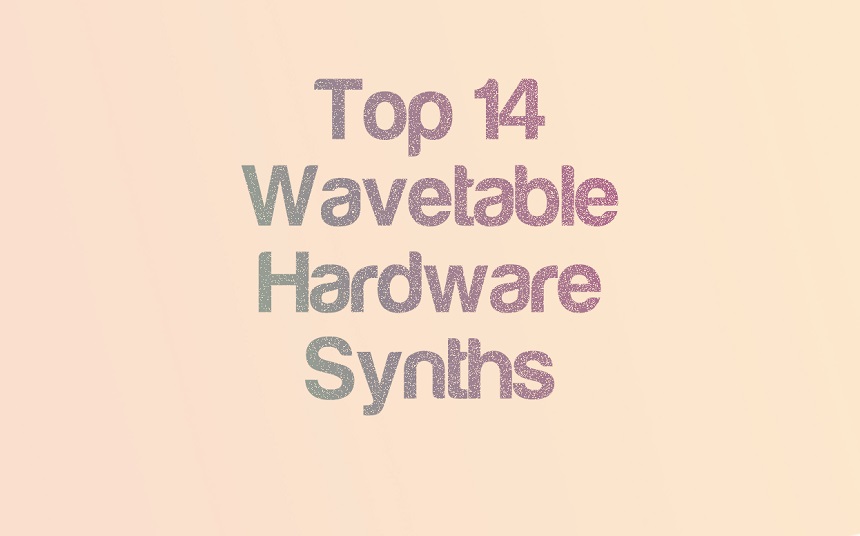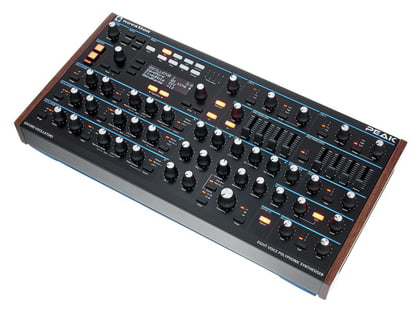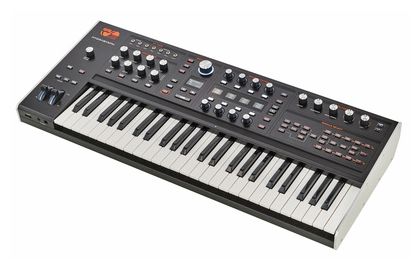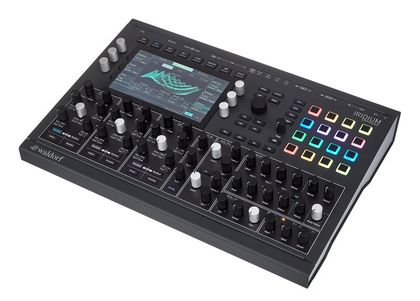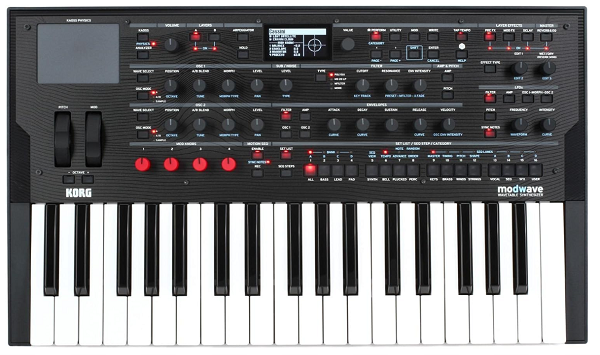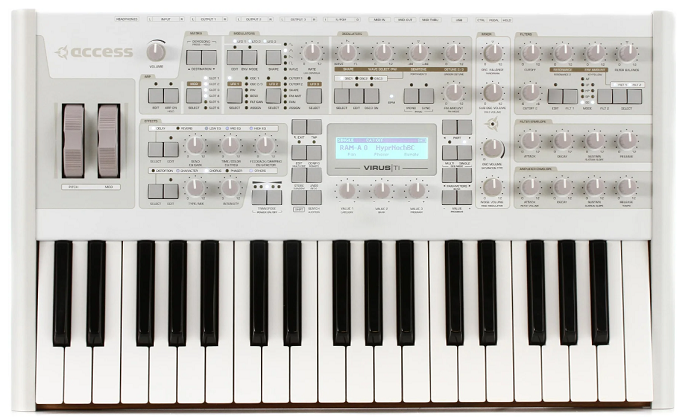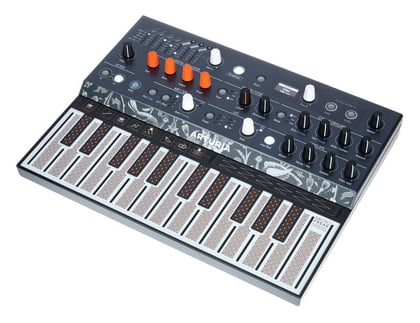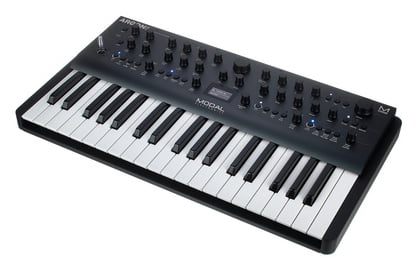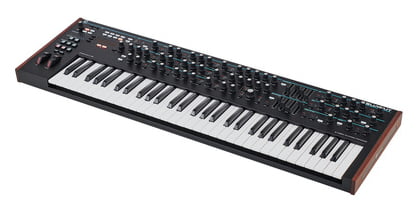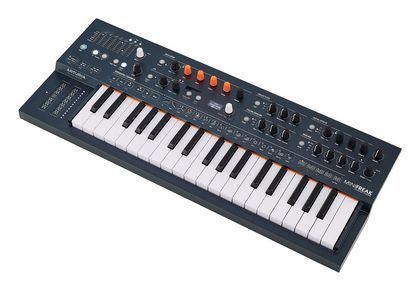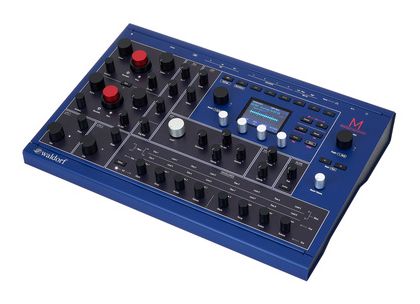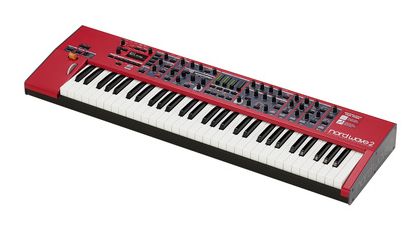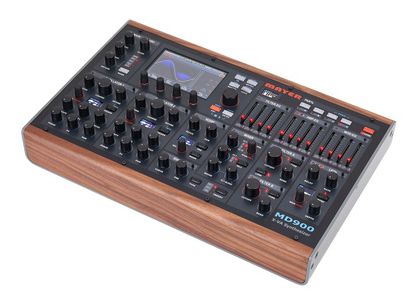This article will discuss the 14 best Wavetable hardware synthesizers available in the market, for any genre.
Wavetable synthesizers have made a lot of waves in recent times and are familiar to users of Serum, Vital, and Massive, which are the most virtual popular synths in 2024. A wavetable consists of multiple waveforms that you can browse and morph through them to create interesting effects.
Wavetable synthesis is often combined with a subtractive and FM synthesis workflow. We have covered the best hardware wavetable synthesizers. Hardware synths give you the capability to produce high-quality sounds by combining analog filters, VCAs, and different styles of realistic effects to your waveforms. The same sonic capability isn’t present in virtual wavetables synths.
So let’s dive right into it!
Wavetable Hardware Synths: 14 Best on Any Budget 2024
1. Novation Peak
The Novation Peak is an 8-voice polyphonic virtual analog synthesizer.
It comes with analog waveform- and digital wavetable oscillators, built to work with computers, bridging the worlds of analog and digital. It is perfect for sound design in the modern electronic music era. Therefore, it could be well utilized by bedroom producers, performing DJs, and even high-end studios.
Furthermore, you can easily utilize it for more complicated modulations and routings, as, for example, the modulation matrix can have up to 17 sources and 40 destinations. But first, let’s look deeper into the main features of this machine.
Key Features:
- Oxford Oscillators
Oxford Oscillators are based on FPGA (Field Programmable Gate Array), which creates less aliasing, hence adding more analog characteristics to the sounds. In addition, there are three oscillators with multiple analog waveshapes like sine, sawtooth, triangle, and pulse width, and 60 digital wavetables from which we could choose multiple waveforms.
- Limitless Modulation
There are 16 direct modulation assignments and a 16-slot modulation matrix that you can assign to introduce more movement to your sounds. Moreover, using the FX Modulation matrix, you can apply modulations to any effects. You can modulate almost anything on the Novation Peak with these many options.
- Wavetable Editor
The wavetable oscillator in this instrument comes with an editor which allows you to edit and even draw waveforms and oscillator shapes. You can even create waveforms from external audio samples with the Audio Import function.
Pros:
As a digital-analog hybrid synth, Peak offers features you will not find in a traditional analog synth, including various wavetables. Further, it’s a versatile and all-in-one synthesizer and offers a good ROI for its price. Lastly, it has high-quality oscillators, a friendly laid-out structure to sound design, and analog multi-mode filters and effects.
Cons:
The biggest con of the Novation Peak is that you cannot use and load your wavetables in it. Instead, you get a wavetable editor, which makes the matter more complex and time-consuming, given that the in-built wavetables are slightly underwhelming. Further, it does not have a keyboard and is not rack-mountable.
2. ASM Hydrasynth Keyboard
The Hydrasynth is a digital instrument with 8-voice polyphony that comes in two different versions.
One comes with a velocity-sensitive 49-keys keyboard with polyphonic aftertouch, and another comes in a desktop version. Both are fully digital synths with virtual analog FM and wavetable oscillators, five envelopes and five LFOs per voice, and an extensive effects section, which makes them perfect for creating bass sounds of all genres & styles.
The Hydrasynth is the debut synthesizer of Ashun Sound Machines, a Chinese company. They priced it at about $1299, which is pretty affordable, given its advanced features and innovative design.
Key Features:
- Next Level Virtual Analog sound design capabilities
The ASM Hydrasynth packs a 32-slot modulation matrix, three Wavescan oscillators with 219 waveforms, and four waveshaping mutators. Each of the five envelopes can sweep through exponential and logarithmic curves, which creates scope for long-evolving modulations and make the synth great for bass sound design.
- High-performance Parameters
For live sound designing and performances, the ribbon controller gives you accessibility to control pitch bend or modulation amount. That lets you create 8o8 sounds with interesting slides, and also funky 80s-type basslines with groovy bends.
PolyTouch gives you more command over the aftertouch curves, offsets, and release times, shaping your sounds in more controlled and creative ways.
- Hands-on control of the interface
The intuitive interface makes your sound design process simpler and easier, with plenty of knobs and buttons to tweak what you’re looking for. In addition, we can easily access each section and functionality of this synth with just a press of a button.
Pros:
Hydrasynth combines several sound design methods, like wavetable synthesis, subtractive synthesis, linear FM, Pulse Width Modulation, and more which gives it limitless functionality, which means that there’s no limit to the genre and style of bass you want to program on it.
Further, eight macro control presents make the sound design workflow easier, combined with a solid build and a high-quality effects section. Lastly, the Polyphonic aftertouch and Ribbon Controller are its topmost USP after its attractive price point.
Cons:
The keyboard has a complex & overwhelming sound design workflow that may take time to get used to. Hence, Hydrasynth is not the most beginner-friendly instrument. Lastly, lacking sequencers could be a huge dealbreaker for many music producers, making its versatility questionable.
3. Waldorf Iridium
The Waldorf Iridium is a sixteen-voice polyphonic bi-timbral stereo digital hardware synth.
It is the desktop version of Waldorf Quantum and includes Quantum’s analog filters for a lower price tag, more voices, smaller footprint, and a few more features. In addition, it includes five synth engines: wavetable, waveform, sampler/granular, resonator, and kernels.
Key Features:
- Sharp & interactive touch screen
It has a seven-inch color touch screen that is sharp, viewable from any angle, and has a good response rate to touches, whether light or hard. You could use this to access and save presets, select effects, oscillators, and modulators, analyze waveforms using its oscilloscope, decide the signal flow, etc.
- Solid built
The synth is heavy and well-built, the encoders and knobs are solid and responsive, and the pads are good quality. It doesn’t have a built-in keyboard, but you can use its pads, arranged chromatically, to play or record any chords or notes. Chords can be customized to single pads as well in chord mode.
- Limitless sound design capabilities
Packed with powerful modulators, the Iridium has a 40-slot modulation matrix, dual filter, six envelope generators, 4×4 pad matrix, six LFOs, and a KOMPLEX modulator which offers highly accurate and precise sound shaping options.
As a sound designer, you can utilize comb filtering, bit crushing, Ring Modulation, and many other modulation & effect tools.
Pros:
It’s an all-in-one machine that blends lots of features well together, creating a seamless user interface, given the number of knobs, buttons, and touch screens we can use to control thousands of parameters.
Further, we can conveniently do many things with the touch screen, like sequencing, arpeggiating, and scrolling around through different waveforms and presets.
Lastly, the screen animations are useful and interactive for visualizing the wavetables, LFOs, modulations, etc. Physically, it looks stunning and compactly packs all features & capabilities of the Waldorf Quantum.
Cons:
Only 600 MB of memory is available for loading up samples or wavetables, which could be expanded to 2.5 GB if you clear the factory presets. Further, the pads are really small and have no pressure after-touch sensitivity.
Lastly, it does not have an SD card or USB stick slot to use or expert external data. Lastly, there are no macro controls, which, if included, could enhance this machine’s performance.
4. Korg Modwave
The Korg Modwave synthesizer combines digital wavetables with analog filters in a futuristic synth design.
The instrument is a great sound designing tool featuring multiple morphable waveforms and wavetables, motion sequencing for creative and expressive playing, the Kaoss pad, and expansive built-in effects like ring modulation, tremolo, waveshaper, etc., for intensive sound-shaping.
Key Features:
- Millions of wavetable variations
It has 200+ wavetables, with 64+ waveforms, that you can further manipulate with Modwave’s morphing features and modifiers. In addition, you can also import wavetables from Serum by Xfer Records. In addition, it includes a PCM library which you can use to add a more realistic and organic quality to your sounds.
- High-quality filters
The filters in the synthesizer are taken from the classic MS-20 and Polysix synthesizers. In addition, these filters include 2- and 4-pole lowpass, highpass, bandpass, and band-reject filters.
- Kaoss Pad
Kaoss Pad is a dynamic effects/sampler instrument and has been used by experimental sound designers/producers/artists like Brian Eno, Radiohead, Muse, etc. The synth also includes Kaoss Physics, modeling the behavior of a bouncing ball for any parameter automation.
Pros:
Motion Sequencing has a “Lanes” workflow that provides a unique way to manipulate pitch, time, step sequencer values, and other properties of sound. In addition, there are thirteen morph-type filters for stretching, squeezing, and altering wavetables in real time. The synth is overall compatible and feature-rich.
Cons:
The plastic body makes it light and portable but also takes away from the ruggedness and physical sustainability of the instrument. The internal jacks are of low quality, making the overall construction and build disappointing. Also, the complex workflow requires you to do some menu diving.
5. Access Virus Ti2 Keyboard
The Virus Ti2 is a wavetable synth with a distinctive characteristic sound and great capabilities.
Access improved the Virus Ti’s calculating power by 25%, countering its criticism for latency and real-time performance issues, and launched the Virus Ti2 with better power & performance, lighter weight, robust design, and more effects to enhance the character of its sound.
The Ti2 also has a software version, which we can use within a digital sequencer on a computer. It’s a 61 keys velocity-sensitive keyboard with good-quality knobs, buttons, and solid construction. Next, let’s dive into the other aspects of this synthesizer.
Key Features:
- Powerful effects section
In addition to a bunch of time-based effects like phaser, chorus, flanger, and frequency-based effects like Ring Modulation, ring shifter, and EQ, the Ti2 lets you add studio-quality effects like Tap Delay, frequency shifter, and distortion effects for harmonic enhancement.
In addition, there are new “character” effects, which lets you adjust the timbral characteristics of sounds using Analog Boost, Bass enhancer, Lead enhancer, Vintage 1/2/3, and Stereo widening. In total, there are 129 parallel effects that you could choose from.
- Virus control plug-in for more control
You can enhance the control over Virus Ti2 using its plug-in version in your preferred DAW, in which you can also access a wider range of presets that you could also sort, edit and search. You can also use the dedicated remote mode to turn this keyboard into a universal remote control for VST/AU plug-ins.
- Efficient sound design capabilities
The Ti2 contains three LFOs (with 64 different waveshapes) and two ADSTR envelopes. It also has two fully independent filters (High pass, low pass, and bandpass) and a MoniMoog cascade filter-inspired Analog Filter.
Further, there are three main oscillators and one sub-oscillator available per voice, in which you can access Wavetable oscillators and HyperSaw oscillators, capable of using up to 9 sawtooths.
Pros:
The Ti2 is a very reliable and heavy-duty piece of gear, made for the rigors of touring due to its high build quality which is usable even in temperature changes and dust and is rock-solid. Built on the virus synth engine, it has a unique flavor, which is hard to emulate by any other synthesizer.
It uses the best of both software and hardware worlds and also comes as a plug-in that we can use inside our DAW. It can also be used as a soundcard, hence the name TI, which stands for total integration. We can control the plug-in synth via the hardware synth, and can Ti2 can also act like a MIDI device and record musical information from it.
Cons:
It doesn’t sound as analogous as other synths in the list, as it is a digital synthesizer. It is not the best device for creating heavy and hard-hitting percussive sounds, which makes this a not-so-versatile instrument because of its one-of-a-kind sonic scape. Also, many of its customers and users have complained about bugs and software issues.
6. Arturia Microfreak
The Arturia Microfreak blends wavetables and digital oscillators with digitally-controlled analog filters.
It brings some great sound design capabilities in very compact and unique packaging. For example, it has a one-of-a-kind poly aftertouch flat keyboard with only two octaves, 16 different oscillator modes, five switchable sound engines, and Noise engineering-based oscillator modes.
Arturia offers companion software for preset management and more control on the device. One can also connect a larger LED/LCD screen to visually monitor the sound design process.
Key Features:
- Futuristic design
Microfreak features a useful and visually pleasing OLED screen that provides good visual feedback for the selected parameter, preset names, waveshape changes, etc.
In addition, it has a matrix knob that lets you assign the target and source for modulations (like Envelope, LFO, CycEnv, Press, Key/Arp, etc.). Similarly, it has many knobs and buttons for various functions built in unconventional styles.
- 12 Oscillator Engines
Arturia has packed twelve sound design engines, including wavetable, virtual analog, FM, Waveshaper, Formant, Additive, Modal, Chords, Speech, Karplus, Formant Engine, and Modal resonator. Furthermore, for each of these, the timbre, shape, and other characteristics of sounds can be edited.
- The All New Touch Surface
The design team behind Microfreak deserves full points for innovation as they have created this sensitive touch keyboard, which you could play faster than a regular keyboard. However, it could take some time to get used to it if you have the habit of playing on a regular keyboard.
Also, you cannot lay your fingers on the keyboard without triggering any note(s) on it.
Pros:
Microfreak is priced at about $300, which is a great price point, given the value one can derive from this device. Next, the chords oscillator is an interesting feature that you can use, which gives a four-voice chord as its output, for which we can select the chord we want to output using the wave knob, and the Timbre knob could select the inversions.
With so many different sound engines, the synth serves multiple synth purposes. We can easily switch between these different sound design algorithms, which is great for the creative aspect of it to inspire new ideas, especially during creative blocks.
Further, the rear of the machine offers a wide range of connectivity, including MIDI, USB, CV out, Gate out, Pressure out, and Clock in/out. Lastly, it’s light in weight and small in size, making it extremely portable.
Cons:
There’s no external audio input, which is a shame because the analog filter is really good and could have been used on different samples and recordings. Moreover, the build quality is not great due to its plastic packaging and fragile keybed. Finally, it sounds too “digital” sonically, given it is primarily a digital synthesizer.
7. Modal Argon 8
Modal Argon 8 is an 8-voice and 37-key polyphonic wavetable hardware synthesizer.
It’s an expansive synthesizer with 100+ effects presets, including Chorus, Flanger, Lo-fi, Tremolo, Rotary, Delay, and Reverb. It has many knobs, buttons/switches, and a display screen to support the process. In addition, there are 500 memory slots (with 300 factory presets) that you can utilize to store, process, and manipulate sounds.
Key Features:
- Rich in effects
It’s a feature-rich machine with multiple effects processors, like de-rez, waveshaping distortion, a great-quality effects engine, filters with insane movements, and envelope generators. You can get great distortion, morphing, and ambient effects with the Argon 8.
- Momentum
You get access to an expansive arpeggiator and a 512-step sequencer which lets you create rhythmic melodies and patterns that could add great momentum to your productions and arrangements.
- Durability
The synth has a steel and aluminum chassis which gives it a great protective physical layer, especially in the studio and live shows, where the equipment is exposed to heat and other adverse conditions. With its rough and tough packaging, the synth is perfect for live touring!
- Connectivity
The synth has a 1/8″ TRS aux input and two 1/4″ main outputs alongside USB MIDI I/O.
The USB connectivity is of type-B, and its software version, “MODAL App Software Editor,” is compatible with a Mac OS X 10.10 or later and Windows 7 SP1 and higher operating systems, and iOS 10 (or later), and Android 6 (or later) mobile software.
Pros:
Its biggest pros are the high-quality build of the synth, thick textures, a built-in arpeggiator, and the modulation capabilities of the Argon 8. In addition, the four-axis joystick, which has a great response rate and high-resolution controllers, gives you hands-on control over your instrument.
Cons:
The synth is quiet, and you may have to ramp up your amp or audio output to get it into full effect. Its sound design capabilities are great, but it has comparatively lesser controllers than other similar synths in the market. Also, the workflow isn’t intuitive and may require massive menu diving and practice before you can exploit its full potential.
Image: Groove Synthesis
Groove 3rd Wave Advanced Wavetable synth is a 24-voice multi-timbral synthesizer.
It has three oscillators per voice, an analog low-pass filter, a state-variable filter, and a wavetable editor. As sound sources, you get 32 classic PPG wavetables and 48 high-res custom wavetables, with each table comprising 64 waveforms. Plus, you also get a linear FM-based synth engine.
Key Features:
- Effects
3rd Wave lets you add up to two digital effects, which you can choose from BBD, stereo delay, tape delay, chorus, phaser, flanger, a distortion pedal, rotating speaker, ring mod, room reverb, hall reverb, and super plate reverb, such that the effects can be synced to the project BPM and their parameters can be modulated within the synth engine.
- Sequencing capabilities
You can create interesting patterns and rhythmic sequences by sequencing notes, effect parameters, filter parameters, and modulation parameters. The synth has four parts of multitimbrality, each of which can be sequenced, so you can create real-time sequences.
- Modulation capabilities
You get sixteen slots of modulations to which you can assign any parameters freely. Plus, there are twelve more fixed-source slots, 27 sources, and 114 destinations.
- Synth engine
Along with analog, wavetable, and FM synthesis, the synth has a six-stage envelope, unison capabilities on the oscillators, fast and efficient optical wave flow, glide function, and oscillator sync. In addition, there’s Dave Rossum designed, classic, 2140 low-pass resonant analog filter, a state variable filter, 4 ADSR+ delay envelopes, 4 LFOs, and more.
Pros:
The wavetable maker that allows you to convert samples to wavetables is a unique and high-utility feature that 3rd Wave offers, which allows you to create custom wavetables. Plus, it provides high-level controls with 77 knobs, 39 buttons, pitch and mod wheels, 500 factory programs, and flexible connectivity.
Cons:
Its huge size may be a con for traveling musicians. The synth is intuitive, but with all the functionalities, it could get complicated and may require some time to get used to.
9. Novation Summit
Summit by Novation is a 16-part digital-analog hybrid wavetable synthesizer.
It has 61 keys and 16 voices of polyphony, such that each voice has three oscillators. The workflow of the synth lets you layer and split two different patches/sounds together to produce innovative and thicker sound textures.
In addition, the intuitive interface has the major controllers and functions, like FM routing, LFOs, arpeggiator functions, etc., displayed on the front.
Key Features:
- Expansive wavetable synthesis
The wavetable sound engine allows you to explore unlimited waveforms, morphing capabilities, and sound design possibilities that go beyond the typical wavetable workflow. The wavetable editor is expansive and flexible.
In addition, it has exclusive content from top EDM producers Noisia and space-themed audio, direct from the NASA sound library.
- Customizations
You can do live editing and draw and edit the waveforms using the drawing tools and Live Edit Mode in the wavetable editor. The wavetable architecture allows you to rapidly drop in audio waveforms and create customized oscillator shapes and waves from them.
- Updated software
The new firmware takes the wavetable synthesis sound design workflow a notch up and lets you expand your creative scope and horizon to give you greater flexibility and freedom.
There are new tools for stereo shaping, a MOD matrix, flexible modulation capabilities, and effects like chorus, flanger, phaser, etc.
- Sound design engine
The instrument consists of 3 NCOs (New Oxford Oscillators), with the option to do subtractive, FM, or wavetable synthesis. In addition, it has dual analog filters, VCAs, an arpeggiator, and a three-stage effects processor.
Pros:
The best part about Summit is its hybrid workflow between digital and analog. In addition, it comes with a three-year warranty, Ableton Live Lite DAW software, and Novation sound collective access. The multitimbral engine and sound stacking enable you to create warm, thick, experimental, and uniquely textured sounds. Lastly, the workflow is easy, intuitive, and
Cons:
One con of Summit is that you cannot copy any parameters. Another is a bug that gets you stuck in the FM settings. In addition, there aren’t any CV/audio outputs on top of the USB/sequencer, the LFO delays have a lesser range than you’d expect and there aren’t any pan controllers.
10. Arturia MiniFreak
MiniFreak by Arturia is a dual oscillator wavetable synthesizer with 37 keys.
It has an oscillator section, an analog filter section, 2 LFOs, a cycling envelope, digital effects section that lets you add up to three effects, and finally an ADSR section. In addition, there’s a built-in arpeggiator, a sequencer, a chord mode, a Glid knob, a modulation matrix, two Macros, a pitch bend modulation wheel, an octave shifter, and more.
Key Features:
- Sound Sources
The instrument allows you to select the type, wave, timbre, shape, and volume of the oscillators. You can also fine-tune its pitch and go to the sound editor/panel to edit, save, and select presets.
- Easy workflow
Whether it’s the velocity-sensitive keyboard, 20 playing modes across a 6-voice polyphony, or all the sound design controllers, the instrument proves to be a great tool. In addition, you also get a MiniFreak V plugin that you can use to expand your horizon of sound design.
- Sonic shaping
Everything from the powerful effects suite consisting of ten effects to the customizable multi-segment LFO, FM/Ring mod, and multi-purpose randomization tools are great for uniquely sculpting your sonics. In addition, there’s a 7 x 13 modulation matrix, 256 factory presets, and 256 open preset slots.
Pros:
The VST is a high-quality counterpart and digital doppelganger of the MiniFreak, which is a huge pro! In addition, the instrument is compact, sounds great, is intuitive, and easy to use. Plus, it’s also versatile as the sounds can range between anything from soft and mellow to hard-hitting, underground, and industrial.
Cons:
It’s not suitable for a piano player or a live performer who needs a keyboard with more keys. Secondly, the workflow may seem a bit weird to people who are exposed to and used to traditional synthesizers. It has 22 algorithms and many synth engines but lacks the depth that some of its competitors have.
11. Waldorf M
Waldorf M is an analog-based desktop wavetable synthesizer.
It consists of two oscillators that can be synced together, with knobs for adjusting the Octave, Semitone, Detune, and Envelope amount. In addition, there are sections for Mix, Voltage-controlled amplifiers, voltage-controlled filters, glide, LFO 1 and LFO 2, envelopes, a display screen, and more.
Key Features:
- Endless modulations
The two LFOs with adjustable rates and shapes, four envelope generators, and loopable 8-point time/level EG allow you to create interesting movements, giving your sound design process a greater push.
- Multiple outputs
The synth has six outputs for pliable routing functions, including two for the main stereo and four aux outputs. In addition, you can use it with your DAW to record up to six audio tracks together, which gives you more sonic options when mixing.
- Other features
The synth includes 2000+ sound programs with 128 multi-programs. In addition, there’s an onboard arpeggiator with a chode mode. The connectivity of the synth is good with its USB and MIDI in/out/thru.
Pros:
The screen is great and bright, the build quality is high, and the filter algorithms are sonically superior and detailed. Overall, the sound quality is at par and gives other wavetable synths in the market a run for their money. Lastly, it’s also compatible with Microwave (SysEx band and sound transfer).
Cons:
Waldorf-M has weak patch management and then it’s held back by its limited range of wavetables. Also, it doesn’t have any effects (analog or digital) built into it.
12. Clavia Nord Wave 2
Nord Wave 2 by Clavia is a virtual analog, wavetable, and samples-based synthesizer.
It has 61 keys, a polyphony of 48 voices, and tweakable hands-on controls and performance. It has a simple and streamlined layout and workflow, which consists of sections like Morph, Vibrato, Voice Mode, Arpeggiator/Gate, LFO, Osc Mod Env, Oscillators, layer control, amplitude envelope, filter, effects, EQ, Delay, and Reverb.
Key Features:
- Sound sources
The Oscillator section has four modes: Analog, Wavetable, FM, and Samples. Multiple voices of unison and controls like shape, sync, and detune allow you good hands-on control over the sound shaping. In addition, there are 2-, 3-, and 4-operator configurations in the FM mode, with harmonic and inharmonic variations.
- Sound sculpting
The instrument consists of six filter types, one of which is a “Mini” transistor ladder filter emulation. Plus, there’s an arpeggiator section with a tempo knob, rate knob, pattern selection button, and more.
Lastly, there’s an LFO section on which you can select multiple waveforms, adjust the amount, and select the destination. There’s also an amplitude ADSR and a filter ADSR.
- Morphing capabilities
You can use Velocity, Aftertouch, Wheel, and Control Pedal to morph different parameters like LFO Amount, Oscillator Control, Filter, and Effects. It’s easy to assign many parameters together to the morphing sources.
- Rhythmic capabilities
The Wave has a Gate section with adjustable depth parameters that lets you create interesting rhythmic patterns. Then there’s an arpeggiator that can be used in a polyphonic mode.
- Sample Editor
You can use the Nord Sample Editor 3 on Mac or Windows operating systems, in which you can drop in your samples, chop them, manipulate them, save them, etc., and play them on the synth.
- Expansive Effects
The effects section consists of Stereo Delay, Ensemble, Chorus, Reverb, etc., such that you can go in-depth into these effects and tweak them to your sensibilities.
Pros:
Everything from the sample editor to the arpeggiator, different synthesis modes, and the expansive effects section makes the Nord Wave 2 a great purchase. It’s one of the most versatile and flexible synthesizers available in the market that lets you layer different sounds, create your own samples, and overall give you a great sound design canvas to work with.
Cons:
There are some limitations to Wave 2. For example, the LFO having only three destination options is a huge bummer. Secondly, you can assign only one destination at a time to it. Secondly, the presets are a bit underwhelming. Lastly, the sliders, knobs, and other controllers are sensitive and may break easily.
13. Mayer EMI MD900
MD900 is a 16-voice and 4-part desktop synthesizer.
It has two oscillator sections, one NOISE section, a mixer, two FILTER sections, three LFOs, a MOD MATRIX, a filter envelope generator, two amplitude EGs, and one modulation EG/ADSR. In addition, it has effects like delay, chorus, flanger, tube-amp, LP filter, dynamic processor/limiter, vibrato, etc.
Key Features:
- One-stop shop
The synth, apart from the sound engine, includes a sequencer and a clip launcher. In addition, you can create MIDI clips in seven columns, including 2 CVs, 4 synths, and drums. The drum columns have a fourteen-channel drum sample player, consisting of channels for snare, hats, kicks, etc.
- Ease of use
MD900 is intuitive and has a straightforward operation, with everything being labeled clearly, and the controls being accurate and hands-on. In addition, the touchscreen and display are bright and lit up, making up for an easy operation, especially on-stage.
- Detailed editing
You can go in-depth with your sound design using the MD900. For example, you can adjust the fine pitch, coarse pitch, detune, amount, waveform, shape, spread, pan, pulse width, and more in the oscillator section. Also, you can shape the noise, and adjust your filters, LFOs, etc.
Pros:
The intuitiveness, hands-on approach, the 5″ LED touch display, the strong aluminum build, and its expanded connectivity are some of the pros of the MD-900. It’s one of the most flexible and detailed synthesizers available in the market. Its rugged case and portability make it great for touring and live shows.
Cons:
Being a desktop synth, it doesn’t have a built-in keyboard. The touch screen allows for deep signal flow adjustments but that could also get confusing. With so much going on, it may require menu diving and time to get used to.
14. Waldorf Blofeld
Blofeld is an affordable desktop wavetable synthesizer.
It has three oscillators, two filters, modulators like filter envelope, amplitude envelope, LFO, a modulation matrix, an effects section, and an arpeggiator. Plus it also has a display screen and two controllers for it. It combines analog-modeled circuitry with modern digital controls and features.
Key Features:
- Sound sources
You get access to up to 25 voices and three oscillators per voice. Plus, it has all microwave II/XT/XTk wavetables installed into it. You can adjust the shape, pitch in semitones, detune, and level of each oscillator.
- Other features
It includes effects like Chorus, Flanger, Phaser, Overdrive, Triple FX, Delay, and Reverb. In addition, the 2 TS analog outputs, 1 TRS output, MIDI i/o, and USB connectivity. Lastly, it’s compact and great for touring musicians/DJs.
Pros:
Blofeld has great presets, and you can create some incredible sounds with it. The best part about it is that it costs only about $500, which is great given its capabilities. The LED display, the seven endless stainless steel dials, and the overall intuitive workflow are its biggest pros.
Cons:
It doesn’t have a MIDI output port and overall limited connectivity. The build quality is not at par, and you may have to be careful with it. Lastly, there could have been more controllers, knobs, sliders, etc., to get a more hands-on feel to it. With the current workflow, it may take a few clicks and steps to do even something simple.

Shaurya Bhatia, is an Indian Music Producer, Composer, Rapper & Performer, who goes by the stage name MC SNUB, and is also 1/2 of the Indian pop music duo, called “babyface”. A certified Audio Engineer & Music Producer, and a practicing musician & rapper for more than 6 years, Shaurya has worked on projects of various genres and has also been a teaching faculty at Spin Gurus DJ Academy.

